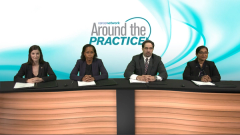
MM: CAR T-Cell Therapy vs Bispecific T-Cell Engagers
Experts on multiple myeloma discuss the mechanism of action and adverse events for teclistamab and compare CAR T-cell therapy with bispecific T-cell engagers (BiTEs).
Episodes in this series

Transcript:
Al-Ola Abdallah, MD: Jordan, going back to you, after CAR [chimeric antigen receptor] T-cell therapy failure, we don’t have any really [good] options. Teclistamab got FDA approved at that time, we decided that she was actually our first patient that we admitted her. I gave her teclistamab. I remember when I came before the third dose, she would tell me that the mass she felt is actually trending down. I [was] holding my breath with the PET scan, making sure it’s actually going down. Can you tell us a little bit about the teclistamab, the side effects, and the mechanics of action?
Jordan Snyder, PharmD: Yes. Teclistamab is a bispecific antibody that binds to CD3 on the T cells and BCMA [B-cell maturation antigen] on the myeloma cells. It’s associated with neutropenia, thrombocytopenia, anemia—all the cytopenias. And then infections, we’ve been seeing a lot of infections, even like you mentioned in the case. This patient has infection and that’s why we had to hold [the medication]. We’ve been seeing a lot of viral infections. But some of our more serious side effects that we see early on is cytokine release syndrome [CRS] or ICANS [immune effector cell-associated neurotoxicity syndrome], which typically happens during the step-up dosing and with the first treatment dose. It usually resolves within 48 hours, but can be pretty significant.
Al-Ola Abdallah, MD: Is there any data about how we actually treat these patients with CRS and ICANS in our institutions?
Jordan Snyder, PharmD: Yes, we manage CRS and ICANS. For CRS [we give] a lot of supportive care management and then administering tocilizumab for grade 2 or worse CRS. If it’s still there or is getting worse, you can consider dexamethasone or alternative agents such as anakinra for the management of CRS. For ICANs, we’re still providing supportive care, considering antiseizure medication as prophylaxis, and then administering dexamethasone for grade 2 or worse ICANs.
Al-Ola Abdallah, MD: According to our internal data, we saw 50% of the time we use tocilizumab in our cases. [Is that] about right so far for this?
Jordan Snyder, PharmD: Yes.
Al-Ola Abdallah, MD: I’ll go back to you, Leyla. I think this is going to be the common question. We have 2 CAR Ts, we have a bispecific T-cell engager that targets BCMA, and Nausheen [Ahmed, MD] is telling me we don’t have any problem in the slot availability. You have the typical [INAUDIBLE] refractory myeloma. What would you choose between a BiTE and the 2 CAR Ts?
Leyla O. Shune, MD: That’s a very good question and it’s an evolving question. Earlier, when we had difficulty with CAR T slot availability, having a BiTE that’s off-the-shelf was very helpful for the patient. So, if a patient will come to me that they are progressing and they require therapy, we just get a BCMA therapy quickly for them. But now that we are able to overcome the difficulty with slots, I feel that CAR T is more of a one-and-done option for the patients.
Currently available we have ide-cel FDA approved and cilta-cel, and with the overall response rates and the PFS advantage, I would prefer to give CAR T to patients who are eligible and who we have a slot available for. [We know] that from the time we collect the T-cells to the time the cells are delivered, there is a [waiting] period there and we have some antigen therapy like the T-cell engagers BCMA, BiTE.
Teclistamab in the MajesTEC trial has an overall response rate of about 60% and the CRS is at 9%. So, it is also a very valuable drug to have. In the near future we’ll have talquetamab, which tags another antigen on the myeloma cell—GPRC5D. So, basically, my goal as a myeloma specialist is to use all these drugs in my myeloma patient’s history. So, if I have the CAR T available and the patient is in a good condition, I’d give that to them. If and when they relapse, I give them another BiTE that can target a different area of the myeloma. I have seen that you could use the same BCMA BiTE in somebody who previously received CAR T. It would work. We’ve seen that in our practice, to our delight. So, I won’t say one or the other, I would say both over a period of time. For the purpose of quality of life, definitely response, and so the patient doesn’t have to come to the clinic all the time, I’d go to the CAR T right away and then save the BiTE later.
Al-Ola Abdallah, MD: OK. So, quality of life, I think, plays a role like comparing to that. And that brings us up to a question for you, Jordan. Leyla just mentioned about that, and, of course, we talk about that in our institution I think we have a different approach for the first dose of treatment for teclistamab. Can you tell us a little bit about what strategy we use for teclistamab first dose in our institution? And, of course, that’s going to be also a question about the community [centers], how can we try to help them out to provide teclistamab there, especially what we do at our academy institution?
Jordan Snyder, PharmD: Teclistamab is administered on days 1, 4, 7, and then weekly thereafter. You do have a bit of wiggle room and can administer the dose 2 days after the previous dose. At our institution, we’ve adopted administering it on days 1, 3, and 5, assuming there’s no CRS or ICANS, in which you would have to delay the dose. This shortens the hospitalization from 9 days to 7 days since they do have to stay for 48 hours after each step-up dose and after the full treatment dose. And I think that is the big question for these community doctors. Reimbursement is an issue, [and so is] having comfortability managing CRS and ICANS. I think until we have a little bit more predictability it’s going to be difficult to roll out into more of the community centers.
Al-Ola Abdallah, MD: Yes, I agree with that. I think there’s always the question about using tocilizumab for those who are high risk for CRS as prophylaxis. That will help us in the future to see if this could be moved totally to outpatient setting. If that happened here, that would be very helpful to actually move teclistamab to be administered in more outpatient settings. Not to forget that there’s a lot of bispecifics coming out soon here. So, we have to find a better way. Admitting a patient for a week or every 3 days or 4 days [is] just not applicable in this case. We want also quality of life, as well, for them.
Transcript edited for clarity.
Newsletter
Stay up to date on recent advances in the multidisciplinary approach to cancer.

















































































